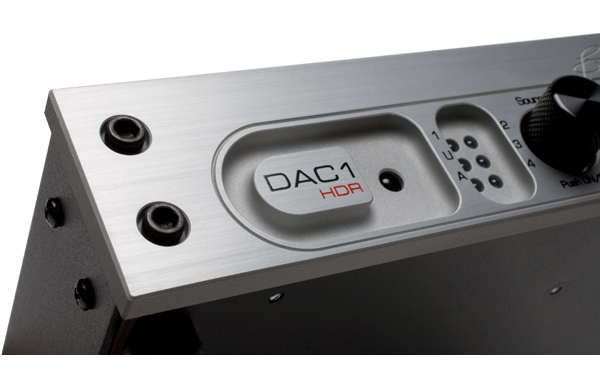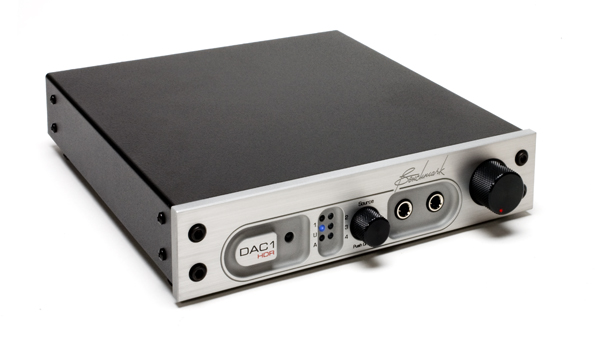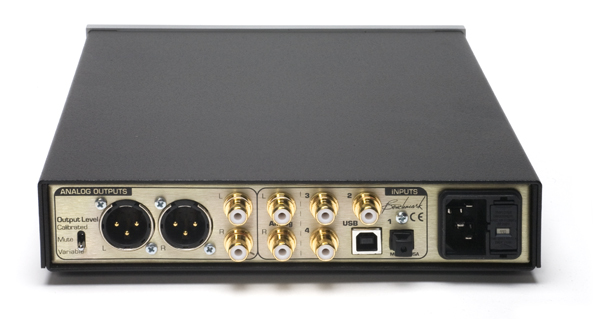Benchmark DAC-1HDR An Excercise in Evolution

All the way back in issue three of TONEAudio, we gave the original Benchmark DAC-1 our first Exceptional Value Award. Through the years, they’ve continued improving this diminutive yet highly powerful piece of audio gear and even though it has gone up in price from $995 when we first reviewed it to $1,895 today it offers a lot more under the hood. Amazingly enough, Benchmark’s engineers have managed to squeeze it all into the original box, so on the outside it looks pretty much the same. For those of you just needing the basic DAC and headphone amplifier, you can still buy the original DAC-1 for the same price of $995. That’s pretty awesome, considering our wacky economic times.
What made the DAC-1 such a great value was the addition of an outstanding headphone amplifier to the package. You’d easily have to spend $400-600 to get this kind of performance with an outboard headphone amplifier and you’d need more cables, etc. The DAC-1 has always included the option of fixed or variable outputs, which has always made it very handy as a linestage in a pinch, or as the cornerstone of a compact, yet high performance audio system. Then, as now, I still can’t think of a product that does more in less space than the Benchmark DAC-1, no matter what version you choose.
A quick history refresher
If you’ve followed the progress of the DAC-1, it originally offered coaxial, XLR and optical digital inputs along with a pair of RCA and XLR outputs. But, we audiophiles always want more and as more people started to use laptops as music sources, Benchmark answered the call and provided the DAC-1 USB, with a USB input. I had mentioned in my review of the DAC-1 USB that this would be the perfect combination if it only had an analog input, so that this could truly be used as a front-end component for that music lover that enjoyed analog as well as digital sources and the DAC-1 PRE was born, featuring an analog input.
They’ve been reading my mind
As cool as the DAC-1 PRE was, I began thinking “now if it only had a remote control…” and before you know it, we now have the DAC-1 PRE. This unit includes the recent op amp upgrades to the last few rounds of the DAC-1, featuring high current LM4562 op amps in every step of the analog path. Comparing the current DAC-1 HDR to the original DAC-1 reveals slightly less grain than the already good original, when playing them side-by-side in my reference system.
However the big change, along with the remote control is the addition of a custom, motorized ALPS volume control. It offered very smooth operation from the remote and perhaps replacing the original volume pot with the ALPS version accounted for a little of that added smoothness. Now the DAC-1 HDR is the perfect compact linestage/headphone preamp/DAC combination. Hmmm, maybe they’ll add a couple of triode tubes to the output stage next? Or a phono preamp? Let’s see those guys at Benchmark squeeze that one in that tiny case!
But seriously
All kidding about vacuum tubes aside, the DAC-1 HDR does a fantastic job with its core technologies. As I said, I made it a point to compare the original to the current model and there is definitely a slight advantage to the latest in regards to smoothness in the treble register.
The strength of the DAC-1 HDR is that it is such a great all around piece. If you are just looking for a DAC or don’t need the analog input, save the money and grab the original DAC-1 or DAC-1 USB.
The sound of the Benchmark as a DAC overall is very neutral and dynamic. While it lacks the bass slam or smoothness of my Wadia 781SE or the new Simaudio Moon 750 that I’ve spent a lot of time listening to, these units cost 7-10 times what the Benchmark does. Regardless of what the measurement geeks want to tell you, there’s more to the sound of a DAC than the bits and you won’t get a $10,000 DAC for a $1,000.
However, the Benchmark still stacks up very well against its similarly priced competitors, offering a neutral midrange, solid bass performance and some airiness to the presentation. What makes it outstanding is the other functions it performs without needing additional interconnects or power cords.
Another extremely cool feature of the DAC-1 HDR is the pair of balanced analog outputs. This allows you to keep the DAC 1-HDR up on a shelf, perhaps with a music server, etc and run a long pair of balanced cables to a power amplifier elsewhere in the room. Which is precisely what I did, pairing the DAC-1 HDR with a few different amplifiers; the McIntosh MC275 (tubes), the Nagra PSA (solid state) and the BAT VK-55SE (tubes). Equally impressive was the DAC-1 HDR’s ability to drive a pair of 20 foot RCA cables as well. This is certainly a very robust output stage!
A superb line stage
Making the DAC-1 HDR the hub of my test system worked well when I added my Technics SL-1200 with Sound HiFi mods and SME tonearm to the mix, along with the Simaudio Moon LP 5.3 phono preamplifier. Digital sources were a Sooloos music server via S/PDIF input and my MacBook Pro via USB.
The Benchmark had no problems playing high res files from either source and recognized the MacBook and a windows Netbook with no glitches whatsoever. I also made it a point to try the TOSLINK connection, with no problem. Gone from the original DAC-1 is the XLR digital input, so if you are one of the rare users that need this for your transport, you will be out of luck on the DAC-1 HDR
The sound of the line stage is just like the analog stage of the DAC; clean, dynamic and neutral. Similar to many of the op amp based preamplifiers I’ve heard, there is a similarity in the sense that an ultimate sense of “airiness” is not present. You can only cram so much into a tiny box and in the Benchmark’s defense, the $3,500 Classe preamplifier I auditioned last year that was full of op amps (and did not have a DAC or headphone amp inside) sounded no better, it’s just the nature of the beast.
Great news for headphone lovers
I’m not sure what I like better about the DAC-1 HDR, the DAC, or the headphone amplifier. Using the new Sennheiser HD-800’s as well as my HD650’s with Stefan Audio Art Cables and AKG 701’s with ALO Audio cabling, I always had a great time listening to my headphones. The DAC-1 HDR spent a fair amount of time in my bedroom system with the Wadia 170i and an iPod full of uncompressed files.
The stereo image provided by the DAC-1 was very wide and the bass performance with the HD650’s and HD800’s was very powerful. The DAC-1 also did a great job at driving the AKG 701’s, which is notoriously tough to drive. If you are primarily a headphone user that would like to build a system around one box (two if you have a turntable) the DAC-1 HDR will be a perfect match for the space limited audiophile that still wants great sound.
Much more than the sum of its parts
If you break it down, the Benchmark DAC-1 HDR is essentially a $700 linestage, a $700 DAC and a $500 headphone amplifier. The sound quality and resolution of each stage compares favorably, comparing each section of the DAC-1 HDR to individual components easily costing twice as much. Back $300-500 out of that price for even the least expensive interconnects and power cords, and this is a value that just can’t be beat.
Again, I am proud to give the latest version of Benchmark’s DAC-1 one of our Exceptional Value Awards for 2010. This is a fantastic anchor to a system in the $4,000 – $10,000 range and one that you will have to pay quite a bit more money to outgrow.
-Jeff Dorgay
The Benchmark DAC-1 HDR
MSRP: $1,895
Manufacturers website:
http://www.benchmarkmedia.com
Peripherals
Analog source Technics SL-1200 w/Sound HiFi Mods, SME 309 Toneram, Simaudio Moon LP 5.3 preamplifier and Lyra Dorian cartridge
Digital sources Sooloos music server, Wadia 170i, McIntosh MCD500 (as transport)
Amplifiers McIntosh MC275, Nagra PSA, BAT VK-55SE, Moscode 402au
Cable Shunyata Aurora, Cardas Golden Reference
Power Running Springs Haley, RSA Mongoose power cord



